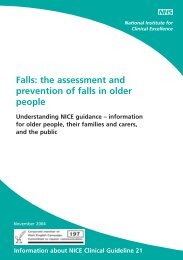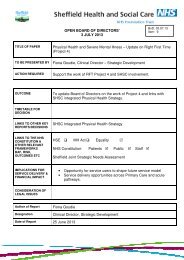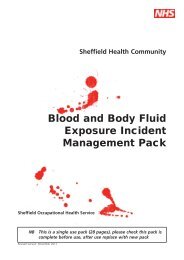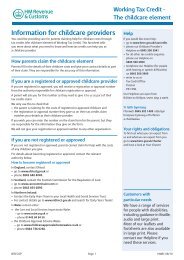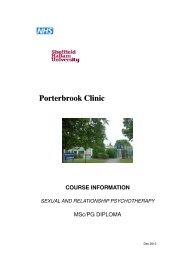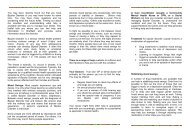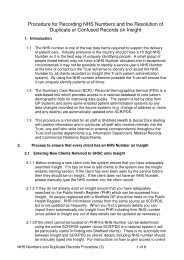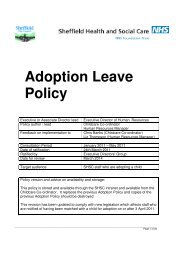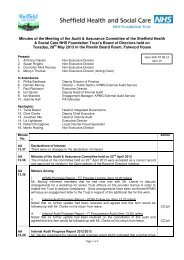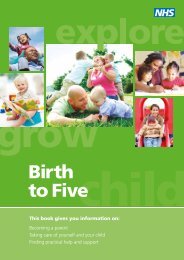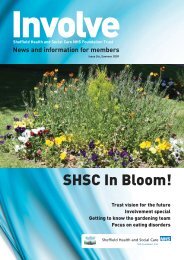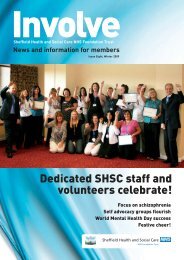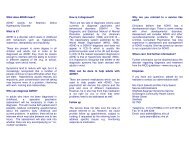Item 8 - Sheffield Health and Social Care
Item 8 - Sheffield Health and Social Care
Item 8 - Sheffield Health and Social Care
You also want an ePaper? Increase the reach of your titles
YUMPU automatically turns print PDFs into web optimized ePapers that Google loves.
13.3.3 Learning from Good PracticeThe Trust utilises a number of methods for ensuringthat good practice <strong>and</strong> lessons learned are sharedacross the services. These include:• Utilising clinical audit/clinicaleffectiveness reports• Quality Improvement Group• Staff <strong>and</strong> service user surveys <strong>and</strong> thedissemination of results• Reports of compliments received <strong>and</strong> thelearning from complaints, incidents <strong>and</strong> claims• Improving quality events• Quality check meetings;• Team <strong>and</strong> directorate governance reports<strong>and</strong> events• Inpatient Forum (formerly Acute <strong>Care</strong> Forum)• Community <strong>Care</strong> Forum• Service User Safety Group• Sharing Good Practice events• Making contributions at conferences• Risk Register Leads meetings.A key learning point from incidents reported in theperiod is ensuring that service users’ families <strong>and</strong>carers are involved in care planning <strong>and</strong> decisionmaking. The Trust is continuing to improve recordkeeping to ensure comprehensive <strong>and</strong> timelyrecords are made. Communication between NHSprofessionals also needs to be strengthened to ensureinformation is shared appropriately.Learning is also shared through the Service UserSafety Group, as well as through a variety ofcommunications, for example Risk ManagementUpdate <strong>and</strong> Litigation News. As Chief Executive, Isend out a monthly letter to all staff, which includesreferences to good practice <strong>and</strong> achievements thatthe Trust has identified.The Trust’s annual Quality Accounts provide abalanced view of the Trust’s performance onquality issues.13.4 The Risk <strong>and</strong> Control Framework13.4.1 Risk Management StrategyThe Trust recognises that positive <strong>and</strong> managedrisk taking is essential for growth, development<strong>and</strong> innovation. ‘Risks’ are not seen as barriersto change <strong>and</strong> improvement; instead they arerecognised, considered <strong>and</strong> managed effectivelyas part of improvements.The Trust’s Risk Management Strategy, which wasrenamed <strong>and</strong> revised during 2012/13 <strong>and</strong> ratified inMarch 2013, is shared with new staff at induction,h<strong>and</strong>ed out at training courses <strong>and</strong> is available onthe Trust’s intranet <strong>and</strong> internet sites, together withother policies <strong>and</strong> procedures to inform practice.The Risk Management Strategy describes:• The Trust’s vision, values, attitude <strong>and</strong> strategicapproach to safety <strong>and</strong> risk management;• The Trust’s structure <strong>and</strong> governancearrangements for safety <strong>and</strong> risk management;• Roles, responsibilities <strong>and</strong> accountabilities forsafety <strong>and</strong> risk management;• The risk assessment <strong>and</strong> management processes;• Key components of risk management, namely:– Board Assurance Framework– Risk Registers– Incident <strong>and</strong> Serious Incident Reporting– Identification <strong>and</strong> analysis, control<strong>and</strong> monitoring,– Learning <strong>and</strong> sharing learning from Incidents,Complaints <strong>and</strong> Claims;• Staff Learning <strong>and</strong> Development• Involving Service Users <strong>and</strong> <strong>Care</strong>rs;• The Trust’s operational approach to riskmanagement;• Using evidence-based practice;• Using information effectively.Other policies related to the effective assessment<strong>and</strong> management of risk are available to all staffvia the Trust intranet <strong>and</strong> internet sites <strong>and</strong> arereferenced in the Risk Management Strategy.A system is in place to prompt the review <strong>and</strong>revision of policies as required.13.4.2 Risk Assessment <strong>and</strong> Monitoring SystemsIdentifying <strong>and</strong> managing risk is embedded in theactivity of the organisation through the governancestructure. This includes service governance withineach of the service directorates <strong>and</strong> agencies, <strong>and</strong>team governance in all clinical teams. Each teamproduces a report at least annually, for directoratereview. All Directorates are reviewed through aregular performance review with the Executive Team.Risks to achieving the Trust’s corporate objectives<strong>and</strong> risks to the viability of the Trust are recorded<strong>and</strong> monitored through the Board AssuranceFramework, which is linked to the broader Trust(Corporate) Risk Register. All risks are assessed usinga stepped approach which identifies <strong>and</strong> analysesthe risk, identifies the control measures in place<strong>and</strong> how effective these are <strong>and</strong> the actions thatneed to be taken to reduce/mitigate/remove therisk. Risks are graded according to their severity<strong>and</strong> likelihood of recurrence, using a 5 x 5 riskgrading matrix based upon guidance produced bythe former National Patient Safety Agency. All risksthat are categorised as moderate or high (scoring12 or above) are entered onto the Corporate RiskRegister, together with all risks that are categorisedas cross-Trust risks, for example, information riskswhich affect more than one directorate. Risks arerecorded on the Ulysses Safeguard system which isan electronic database with sub sections for eachdirectorate. Within directorates, individual teamsor departments also have their own sub-sections.All recorded risks have an accountable individual<strong>and</strong> are reviewed <strong>and</strong> monitored by the appropriateoperational governance group.Directorate Risk Registers are reviewed as part ofthe service review process to ensure that they are‘live’ <strong>and</strong> being managed effectively <strong>and</strong> efficiently.Each directorate has a risk register lead who isresponsible for reviewing <strong>and</strong> maintaining their riskregister. The Corporate Risk Register is administeredby the Risk Register Co-ordinator, who also providesadvice, support <strong>and</strong> guidance for the directorate riskregister leads.All high level risks are reported to the ExecutiveDirectors Group <strong>and</strong> the Board of Directors monthlyusing a Board Risk Profile. The Corporate RiskRegister is reviewed <strong>and</strong> reported to the ExecutiveDirectors’ Group, the Quality Assurance Committee<strong>and</strong> the Audit <strong>and</strong> Assurance Committee quarterly.Risks are also highlighted via feedback from incidents,including serious incidents, complaints, concerns,claims <strong>and</strong> other queries. The Executive Directors’Group, Clinical, Service <strong>and</strong> Support Directors receivea monthly overview of all on-going serious incidents.Directorates also receive monthly reports on theirown incidents..The Quality Assurance Committee of the Board ofDirectors <strong>and</strong> directorates receive quarterly reportson incidents <strong>and</strong> complaints which analyse thedata from these sources for any trends <strong>and</strong> issuesidentified. National benchmarking information fromthe National Patient Safety Agency (responsibilitiespassed to National Commissioning Board) is usedto underst<strong>and</strong> <strong>and</strong> interpret the Trust’s incidentreporting patterns. The findings of external inquiries<strong>and</strong> national reports are also shared <strong>and</strong> acted uponas described in the Trust’s National ConfidentialEnquiries Policy.13.4.3 Board Assurance FrameworkThe Board has an approved Board AssuranceFramework for the period 1st April 2012 to31st March 2013, which was last approved by theBoard in March 2013. The Assurance Frameworkis based on the Trust’s strategic aims, as describedin the Annual Business Plan, <strong>and</strong> the corporateobjectives derived from these strategic aims. TheBoard Assurance Framework was further developedthis year to take into account recommendationsfrom Internal Audit reports. Key high level <strong>and</strong>corporate risks identified through risk registerswere incorporated during the development ofthe Framework.Implementation of the actions in the BoardAssurance Framework is monitored through theExecutive Directors’ Group. The Framework isup-dated <strong>and</strong> reviewed quarterly by the ExecutiveDirectors’ Group <strong>and</strong> the Audit <strong>and</strong> AssuranceCommittee <strong>and</strong> bi-annually by the Board.As at 1st April 2013, there are no high level risksrecorded on the Assurance Framework. There are,however, a number of risks graded as moderate orbelow. The Board Assurance Framework recordsrisks associated with the achievement of the Trust’sstrategic objectives <strong>and</strong> acknowledges <strong>and</strong> identifiesareas where improvements are required. However,none of the areas identified are deemed to besignificant or pose a serious risk to the effectiveness139140



